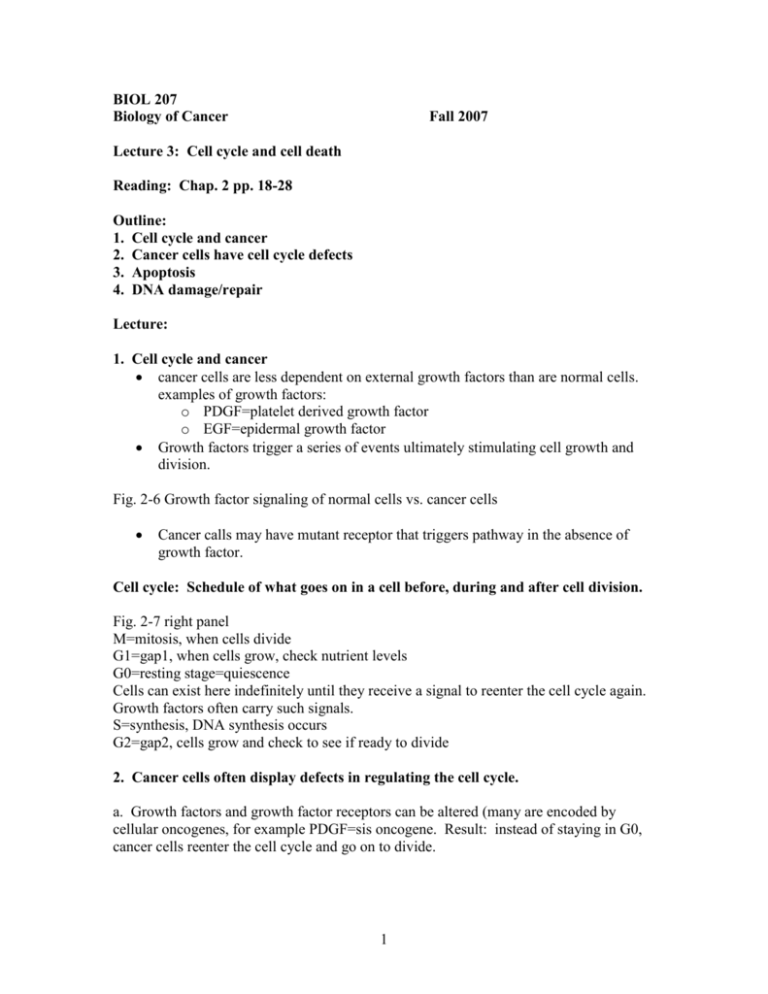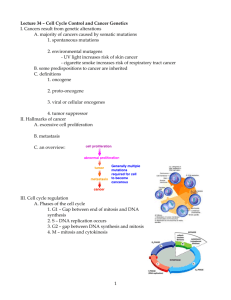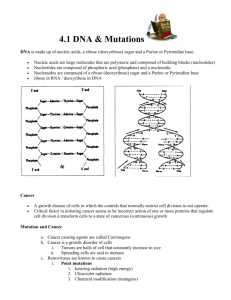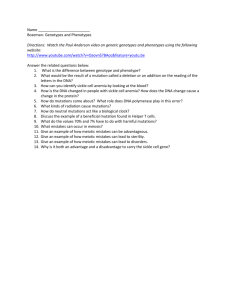BIOL 207
advertisement

BIOL 207 Biology of Cancer Fall 2007 Lecture 3: Cell cycle and cell death Reading: Chap. 2 pp. 18-28 Outline: 1. Cell cycle and cancer 2. Cancer cells have cell cycle defects 3. Apoptosis 4. DNA damage/repair Lecture: 1. Cell cycle and cancer cancer cells are less dependent on external growth factors than are normal cells. examples of growth factors: o PDGF=platelet derived growth factor o EGF=epidermal growth factor Growth factors trigger a series of events ultimately stimulating cell growth and division. Fig. 2-6 Growth factor signaling of normal cells vs. cancer cells Cancer calls may have mutant receptor that triggers pathway in the absence of growth factor. Cell cycle: Schedule of what goes on in a cell before, during and after cell division. Fig. 2-7 right panel M=mitosis, when cells divide G1=gap1, when cells grow, check nutrient levels G0=resting stage=quiescence Cells can exist here indefinitely until they receive a signal to reenter the cell cycle again. Growth factors often carry such signals. S=synthesis, DNA synthesis occurs G2=gap2, cells grow and check to see if ready to divide 2. Cancer cells often display defects in regulating the cell cycle. a. Growth factors and growth factor receptors can be altered (many are encoded by cellular oncogenes, for example PDGF=sis oncogene. Result: instead of staying in G0, cancer cells reenter the cell cycle and go on to divide. 1 b. Moving through the cell cycle involves several proteins called cyclins that are unstable and controlled by regulatory enzymes called cyclin-dependent kinases (cdks)— kinases add phosphates to other enzymes. Some cancers are associated with mutant cyclins or mutant cdks. c. Many cancers have mutations in their tumor suppressor genes, such as the key regulatory gene, Rb (retinoblastoma, named for the eye cancer most associated with its loss). Rb interacts with cyclin-cdks to regulate the G1/S restriction point. Others have mutations in the tumor suppressor p53, which moniters cells for DNA damage and functions in several cell cycle checkpoints to prevent damaged cells from dividing. 3. Apoptosis=preprogrammed cell death pathway Cancers can result from uncontrolled growth. They can also result from not enough cell death. Fig. 2-13 Cell death is triggered by insults to cells such as too much DNA damage (pathway 2). o p53 sends a signal to the mitochondrion o mitochondria release the respiratory chain enzyme cytochrome c. o cytochrome c triggers a death pathway called the caspase cascade that results in cell death. The caspase cascade can also be directly triggered from the outside (pathway 1). Cells of the immune system secrete molecules that can trigger cells to die. Many abnormal cells and cancer cells are killed in this way. In cancers, certain aspects of this pathway can be altered Bcl-2 is a protein that normally prevents cell death; if overproduced, not enough cell death occurs, and leukemias and lymphomas can result. Many cancer-causing viruses produce proteins that interfere with the cell death pathway. 4. DNA damage, DNA repair and cancer. Commonly, we find DNA damage causes mutations that lead to cancer. What causes DNA damage? Chemical carcinogens Radiation Fig. 2-15 Some types of environmentally induced DNA damage are o Depurination (remove G base) o Deamination (remove NH3 groups from C makes it a U) 2 o Thymine dimers (two adjacent Ts get linked together) When DNA is replicated, mistakes may be kept, causing mutations. Cancer results from several mutations in oncogenes and tumor suppressor genes. Most mistakes in DNA are corrected. o Fig. 2-16: an example of excision repair. Hereditary skin cancer (Xeroderma pigmentosum) is associated with mutations in some of the genes for enzymes in excision repair. o Mutations in another repair pathway called mismatch repair are associated with several forms of hereditary colon cancer (HNPCC). Cancer cells are often genetically unstable and may have severe chromosomal defects. Fig. 2-19: Philadelphia chromosome associated with chronic myeloid leukemia. The Philadelphia chromosome is associated with a translocation (Exchange between two different human chromosomes, 9 and 22. Note for exam I: need not know in detail Figs. 2-9, 2-12, 2-16,2-17, 2-18. 3








